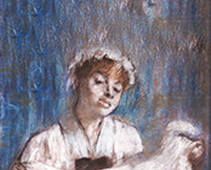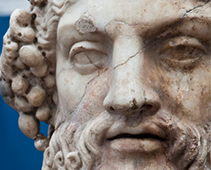Map of Egypt with the sites excavated by Flinders Petrie and his associates. The Glyptotek holds finds from the sites marked with red.
THE PETRIE PROJECT
TEXT
The famous English Egyptologist and archaeologist, W.M.F. Petrie is often called “The Father of Archaeology”. The Glyptotek’s Egyptian collection includes many exciting discoveries from his and his contemporaries’ excavations at the beginning of the 20th century. They have now been examined closer and put into context.
W.M.F. PETRIE AND THE NEW CARLSBERG FOUNDATION
At the beginning of the 20th century, the New Carlsberg Foundation supported excavations in Egypt undertaken by the English Egyptologist and archaeologist, W.M.F. Petrie, and some of his contemporaries. It was common practice at the time for the unique finds from an excavation to remain in Egypt, while the remainder could be distributed among the sponsors. In this way find groups were split up and are to be found today in various museums in Egypt, Europe, the USA and as far away as Australia. The New Carlsberg Foundation’s share was turned over to the Glyptotek.
“THE FATHER OF ARCHAEOLOGY” IN EGYPT
Petrie began his career in Egypt in 1880, when, as a 26 year-old he surveyed the site of the Pyramids at Giza and the Great Pyramid of Kheops. He became fascinated by the work in Egypt and went on to excavate innumerable locations, where he often lamented the heavy-handed excavation methods of earlier times. As he was a pioneer in methodical archaeology and undertook more detailed documentation than his predecessors, he is often called “The Father of Archaeology”. Every year he published an annual excavation report with illustrations.
THE PETRIE FINDS AT THE GLYPTOTEK
The Carlsberg Foundation’s Petrie Project has examined all the objects in the Egyptian collection which came from Flinders Petrie’s excavations. It has been documented precisely where each comes from and they have been studied in connection with finds from the same excavations, the same tombs, and same temples etc. which are now in other museums. They are thus put into a broader context and so contribute to an understanding of these finds spots. The Petrie discoveries at the Glyptotek are, in this way, also part of a larger network of collections and museums with corresponding finds.




